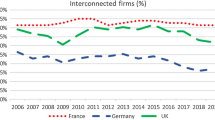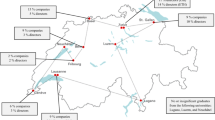Abstract
The rate of publication of interlocking directorate research in recent years is examined. The data show that the rate of reporting research on interlocking directorates has been leveling off since 1983. Methodological, theoretical, and sociology of knowledge explanations of this trend are provided. The future of interlocking directorate research is discussed, and theoretical reasons are posited to show that there is a need to continue these studies. Suggestions for future research are also offered.
Similar content being viewed by others
References
Aldrich, Howard E. 1979.Organizations and Environments. Englewood Cliffs, N.J.: Prentice-Hall.
Atwood, William, J. Bearden, P. Freitag, C. Hendricks, P. Mariolis, B. Mintz, M. Mizruchi, D. Palmer, M. Schwartz. 1985. “Data Collection and Analysis for the Mathematical Analysis of Corporate Networks (MACNET).” Pp. 257–77 inThe Power Structure of American Business by Beth Mintz and M. Schwartz. Chicago: University of Chicago Press.
Berle, Adolph, and G. Means. 1932.The Modern Corporation and Private Property. New York: Macmillan.
Burris, Val. 1987. “The Political Partnership of American Business: A Study of Corporate Political Action Committees.”American Sociological Review 52: 732–44.
Burt, Ronald. 1980. “Cooptive Corporate Actor Networks: A Reconsideration of Interlocking Directorates Involving American Manufacturing.”Administrative Science Quarterly 26:557–82.
———, K. P. Christman and H. C. Kilburn. 1980. “Testing a Structural Theory of Corporate Cooptation: Interorganizational Directorate Ties as a Strategy for Avoiding Market Constraints on Profits.”American Sociological Review 45:821–41.
Clawson, Dan and Alan Neustadtl. 1989. “Interlocks, PACs, and Corporate Conservatism.”American Journal of Sociology 94:749–73.
———, A. Neustadtl, and J. Bearden. 1986. “The Logic of Business Unity: Corporate Contributions to the 1980 Congressional Elections.”American Sociological Review 51: 797–811.
Domhoff, G. William. 1967.Who Rules America? Englewood Cliffs, N.J.: Prentice Hall.
Dooley, Peter C. 1969. “The Interlocking Directorate.”American Economic Review 59:314–23.
Eitzen, D. Stanley, M. A. Jung, and D. A. Purdy. 1982. “Organizational Linkages Among the Inner Group of the Capitalist Class.”Sociological Focus 15:179–89.
Ford, Ramona L. 1988.Work, Organization, and Power: Introduction to Industrial Sociology. Boston: Allyn and Bacon.
Glasberg, Davita and M. Schwartz. 1983. “Ownership and Control of Corporations.”Annual Review of Sociology 9:311–32.
Mariolis, Peter and M. H. Jones. 1982. “Centrality in Corporate Interlock Networks: Reliability and Stability.”Administrative Science Quarterly 27:571–84.
Mintz, Beth and M. Schwartz. 1981. “Interlocking Directorates and Interest Group Formation.”American Sociological Review 46:851–69.
Mizruchi, Mark S. 1982.The American Corporate Network: 1904–1974. Beverly Hills: Sage Publications.
——— and Thomas Koenig. 1986. “Economic Sources of Corporate Political Consensus: An Examination of Interindustry Relations.”American Sociological Review 51:482–91.
Neustadtl, Alan and D. Clawson. 1988. “Corporate Political Groupings: Does Ideology Unify Business Political Behavior?”American Sociological Review 53:172–90.
Ornstein, Michael. 1984. “Interlocking Directorates in Canada: Intercorporate or Class Alliance?”Administrative Science Quarterly 29:210–31.
Palmer, Donald. 1983. “Broken Ties: Interlocking Directorates and Intercorporate Coordination.”Administrative Science Quarterly 28:40–55.
———, R. Friedland and J. V. Singh. 1986. “The Ties that Bind: Organizational and Class Bases of Stability in a Corporate Interlock Network.”American Sociological Review 51:781–96.
Ratcliff, Richard E. 1980. “Banks and Corporate Lending: An Analysis of the Impact of the Internal Structure of the Capitalist Class on the Lending Behavior of Banks.”American Sociological Review 45:553–70.
Richardson, R. Jack. 1987. “Directorship Interlocks and Corporate Profitability.”Administrative Science Quarterly 32:367–86.
Roy, William G. 1983. “The Unfolding of the Interlocking Directorate Structure of the United States.”American Sociological Review 48:248–57.
——— and Phillip Bonacich. 1988. “Interlocking Directorates and Communities of Interest Among American Railroad Companies, 1905.”American Sociological Review 53:368–79.
Stearns, Linda B. and M. S. Mizruchi. 1986. “Broken-Tie Reconstitution and the Functions of Interorganizational Interlocks: A Reexamination.”Administrative Science Quarterly 31:522–38.
Useem, Michael. 1979. “The Social Organization of the American Business Elite and Participation of Corporation Directors in the Governance of American Institutions.”American Sociological Review 44:553–72.
———. 1982. “Classwide Rationality in the Politics of Managers and Directors of Large Corporations in the United States and Great Britain.”Administrative Science Quarterly 27:199–226.
Zeitlin, Maurice. 1974. “Corporate Ownership and Control: The Large Corporation and the Capitalist Class.”American Journal of Sociology 79:1073–119.
Author information
Authors and Affiliations
Additional information
He is doing his dissertation research on the influence of economic and political factors on declining unionism in the United States.
Rights and permissions
About this article
Cite this article
Kirkpatrick, K. Publication trends of interlocking directorate studies. Am Soc 21, 257–270 (1990). https://doi.org/10.1007/BF02692425
Issue Date:
DOI: https://doi.org/10.1007/BF02692425




